IPS
e.max Ceram – G I N G I V A ®
IPS e.max Ceram Gingiva layering materials can be used to create a lifelike gingiva, particularly for implant superstructures. The materials are applied together with the Dentin and Incisal materials and fired. A total of 13 ceramic materials are available for fabricating the gingival portions. For determining the gingival characteristics a shade guide which shows the different Gingiva materials after firing is available.
Gingiva ZirLiner
G1
G2
G3
G4
G5
IG1
Gingiva
IG2
IG3
IG4
E20 rose
Intensive Gingiva
E21 berry Essence
Note: As with the tooth-shaded layering materials, gingival portions made of IPS e.max Ceram have to be adequately supported by a respective zirconium oxide framework. Please observe the following procedure: – Before layering, apply IPS Model Sealer on the model and allow it to dry. After that, isolate the corresponding areas using IPS Ceramic Separating Liquid. – For frameworks made of zirconium oxide, the IPS e.max Ceram ZirLiner Gingiva or a tooth-shaded ZirLiner has to be fired on the gingival areas. (application of ZirLiner see page 32/observe the firing parameters). – The ZirLiner Gingiva is applied together with the tooth-shaded ZirLiner and fired. – Mix the required IPS e.max Ceram layering materials (e.g. Dentin, Deep Dentin, Incisal, Gingiva) with the Build-Up Liquids allround or soft. If another consistency is desired, the liquids may also be mixed with each other at any mixing ratio. – Underlay the pontic areas of bridges with Deep Dentin in the next lighter shade. – Place the framework on the model and make sure it is correctly positioned. – Layer tooth-shaded areas of the restoration according to the layering diagram. – Depending on the restoration size and extension of the gingival portions, the Gingiva materials can be applied with the first or second Dentin/Incisal firing. – Use the Gingiva materials to create the basal rest of the restoration on the “natural” gums. In order to ensure proper oral hygiene of the inserted restorations, observe a homogeneous basal area free of pores and a correct shape. – Apply the vestibular and oral portions of the gingiva. – Do not apply excessive suction and prevent the restoration from drying out. – Before firing, all the interdental areas must be separated down to the framework using a scalpel. – Position the restoration on the firing tray and fire it according to the firing parameters for Dentin/Incisal firing. – If required, an additional Dentin/Incisal firing can be conducted. Moreover, the gingival portions can be adjusted.
47
E22 aubergine
